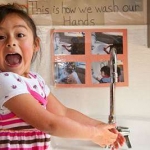 The University of California, San Francisco, Institute for Health and Aging, Informed Green Solutions and the Center for Environmental Research and Children’s Health introduce their new publication.
The University of California, San Francisco, Institute for Health and Aging, Informed Green Solutions and the Center for Environmental Research and Children’s Health introduce their new publication.
Nearly 11 million children under age 5 spend time in some type of child care arrangement each week. Children may spend an average of 35 hours a week in early care and education (ECE) facilities; many spend the majority of their waking hours in an ECE program. Every child care professional knows that regular cleaning, sanitizing, and disinfecting are important for maintaining attractive and healthful conditions in early care and education (ECE) settings. Besides the obvious aesthetic benefits of cleaning, removing dust, allergens, and infectious agents is important for maintaining a healthful indoor environment. But many don’t know that some cleaning products and disinfectants present significant health and environmental concerns and that certain chemicals in these products are associated with asthma, eye, skin, and respiratory irritation, as we
Small children are particularly vulnerable to health effects from exposure to chemicals in cleaning, sanitizing, and disinfecting products because of their size, stage of development and behaviors. But there are easy steps you can take to maintain a clean and healthy child care facility while at the same time reducing exposure to harmful chemicals.ll as other health issues.
To assist ECE programs in implementing a cleaning program that uses safer products and procedures, the California Department of Pesticide Registration (DPR) funded the development of the publication, “Green Cleaning, Sanitizing and Disinfecting: A Toolkit for Early Care and Education.” The Toolkit is a user-friendly resource designed to educate early care and education (ECE) directors, providers, parents, and child care regulators on health risks of commonly used cleaning products and antimicrobial pesticides and to provide the tools programs need to transition to a “green cleaning” program.
The Toolkit includes a curriculum, fact sheets, posters, a checklist, and a wallet card. It educates child care providers on the risks of commonly used cleaning products and antimicrobial pesticides and offers reduced-risk and non-chemical options.
The Toolkit was co-authored by Dr. Vickie Leonard with UC San Francisco’s Institute on Health and Aging (principal investigator), Carol Westinghouse with Informed Green Solutions and Dr. Asa Bradman with UC Berkeley’s Center for Environmental Research and Children’s Health. It can be downloaded from the Center for Environmental Research and Children’s Health website at: http://cerch.org/greencleaningtoolkit/
Hard copies can be ordered at the Informed Green Solutions website at: http://www.informedgreensolutions.org/?q=publications/green-cleaning-toolkit.


